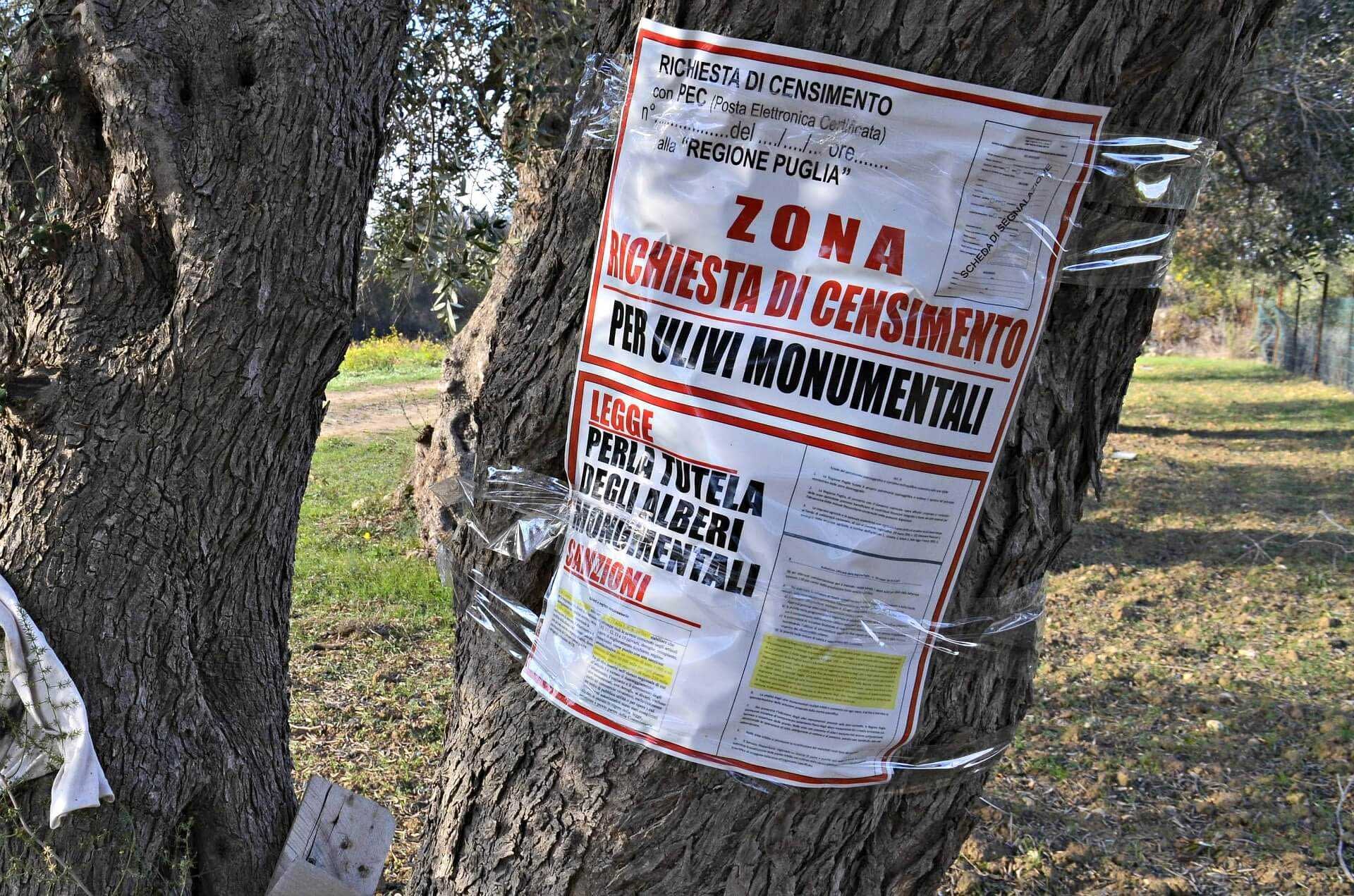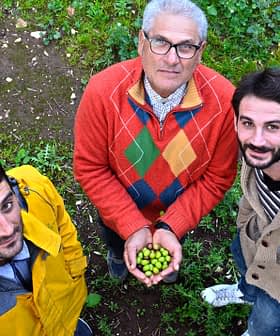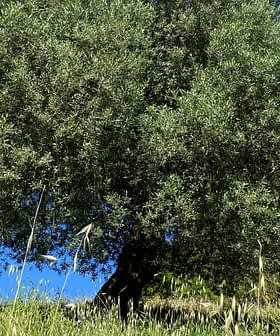Puglia Mandates Pesticides In Fight Against Xylella, Sparking Protests
To combat the spread of the olive-killing Xylella fastidiosa bacterium, Italian agricultural officials are telling farmers to use pesticides to kill the disease's vectors, three spittlebugs, but this mandate has sparked protests and outrage.
 May 25 protest in Bari on the mandated use of pesticides to combat Xylella fastidiosa (Photo: Frans van Munster)
May 25 protest in Bari on the mandated use of pesticides to combat Xylella fastidiosa (Photo: Frans van Munster)To combat the spread of the olive-killing Xylella fastidiosa bacterium, Italian agricultural officials are telling farmers to use pesticides to kill the disease’s vectors, but the mandate has sparked protests and anger.
Nature heals itself. If we fight against it, that’s not good.
Puglia’s regional government recently issued the call for commercial olive growers to apply pesticides two times between May and August to kill the meadow spittlebug adults. The insecticides contain acetamiprid or deltametrina. Organic farms are being allowed to use other products, according to the mandate.
This new demand is the latest drastic step to control the devastating disease blamed for the death of thousands of olive trees in Italy’s boot-heel region of Puglia, where Xylella was first spotted five years ago.
But organic farmers and environmentalists are outraged at the new mandate, which is viewed as yet another misguided policy in how to deal with the spread of Xylella, a fatal bacterium for olive trees native to Central America.
Many in Puglia believe that long-standing mandates to cut down infected olive trees and other measures, such as clear-cutting tracts near infected trees, have been unnecessary and heavy-handed.
These sentiments have been fueled by some scientists who maintain that Xylella is not the chief cause of the outbreak of the disease in olive trees, which is also known as the Olive Quick Decline Syndrome, or OQDS.
These scientists run counter to a growing body of researchers who blame the over-reliance on chemicals, poor farming practices and fungi for causing olive trees to quickly sicken.
“Xylella is the enemy that must be fought,” said Margherita Ciervo, a geographic political economist at the Università degli Studi di Foggia, a university in Puglia. “But this is a reductionist theory.”
She is unconvinced, based on her studies, that Xylella fastidiosa is the prime cause for the leaf-scorching taking place in Puglia’s olive orchards.
She said that a kind of hysteria has dominated the scientific and political discourse over what is happening to Puglia’s olive trees. For example, she said, Puglia’s regional officials have officially identified only 3,058 infected trees but the media regularly cites estimates by scientists that thousands of trees of olive trees have been infected.
“What is interesting is that lands right next to each other are different,” she said in a telephone interview. “In lands where organic farming has been practiced there is no leaf-scorching, and then nearby, where chemicals have been used, there are infected trees.”
But the majority of scientists and agriculture officials say local resistance to these policies has helped cause the disease to spread. The use of pesticides is a fraught issue.
The spraying of pesticides has been linked to a series of baleful effects to the natural world, most famously in the groundbreaking work presented in Silent Spring, a book written by Rachel Carson in 1962. She linked pesticides to widespread death in the plant and animal worlds.
But in this case, authorities say that pesticides must be applied to stop Xylella’s spread. The use of pesticides is called for under European Union regulations when a plant disease of this severity is found.
Anca Păduraru, a spokeswoman for Health, Food Safety and Energy Union projects at the European Commission, said the use of pesticides is not illegal if the chemicals applied have been approved by the European Union or specifically authorized.
In an email to Olive Oil Times, she added that “all necessary measures to eradicate it” must be taken and “to inhibit its further spread.”
The European Commission calls Xylella fastidiosa one of the most dangerous plant bacteria in the world, a threat not only to olive trees but to a wide variety of other crops such as almonds and grapevines. Different subspecies and strains of Xylella attack different crops. The strain of Xylella in southern Puglia affects almonds but not grapes.
Xylella has continued to spread in Europe. Genetically different types of the disease were found in mainland Spain earlier this year and in Corsica and southern France.
Francesco Porcelli, an entomologist at the University degli Studi di Bari Aldo Moro, said the use of pesticides can be effective in killing spittlebugs and controlling the pathogen invasion. He downplayed the environmental threats posed by the chemicals officials are asking farmers to use.
“We are not speaking about DDT, but about pesticides with a shorter life,” he said in a telephone interview.
But he faulted this latest decree for being drafted by bureaucrats without the input of scientists. He said pesticide spraying is expensive for a farmer and that it must be done at the right time.
The decree was issued too late in the year and there needs to be more analysis of how and when to treat trees, Porcelli said. He is working with farmers on methods to inject trees with acetamiprid, both to better kill spittlebugs on the trees and to avoid contamination.
Still, many farmers in Puglia, the epicenter of the outbreak, are on the defensive and say EU and Italian authorities are taking the wrong approach.
“Nature heals itself. If we fight against it, that’s not good,” said Tony Ballestra, a 60-year-old olive tree farmer in Oria. He believes the olive tree disease is caused by the overuse of chemicals which has led to their decline.
“To save the trees it’s necessary to return to organic farming,” he said in a telephone interview. He said on the organic farm he runs with his wife there are no diseased trees.

A poster is affixed to the tree requesting protection for old monumental olive trees. (Photo: Cain Burdeau for Olive Oil Times).
On May 25, hundreds of protesters, among them farmers, held a protest in Bari outside the region’s agriculture offices to decry the push to use pesticides. In the meantime, the Xylella crisis deepens in Puglia, according to new data.
Today, about 775,000 hectares are suffering from Xylella infestation, according to new research, said Donato Boscia, a lead researcher and coordinator against the Xylella outbreak at the Institute for Sustainable Plant Protection in Bari.
By comparison, in 2013, when the olive disease was first identified, researchers found about 8,000 hectares were infected.
In a so-called “zona cuscinetto,” a buffer zone, between 2016 – 2017, researchers found a single tree infected with Xylella and, in the latest surveys, 19 trees have been found with the bacterium, Boscia said.
Meanwhile, in the “containment zone,” 892 trees were found to be infected between 2016 – 2017 and, in the latest surveys 3,815 trees were infected. “This confirms that the bacterium is expanding,” Boscia said.
The most intensive eradication efforts take place in these two zones in the hope of stopping the disease from spreading beyond the boot-heel of Italy.
Meanwhile, in areas already devastated by Xylella farmers and researchers are working together to plant resistant olive varieties, revive afflicted orchards by heavy pruning, grafting, better soil management and the application of more organic sprays.
Alexander Purcell, a foremost expert on Xylella at the University of California at Berkeley, said pesticides are for now one of the only methods for stopping the disease’s spread.
“Pesticides hit a nerve with most people,” he wrote in an email. “Even more so in Europe than in the US.” But, he said, the use of pesticides “looks like one of the stop-gap measures” that can slow the disease’s spread in “newly afflicted areas and those nearby.”
He noted that pesticides alone are not sufficient and their use must go hand-in-hand with cutting down and removing infected trees in order to prevent spittlebugs from acquiring the bacterium and transmitting it to healthy trees.
He said the meadow spittlebug is clearly “the major force behind the olive disease’s spread in Puglia.”
He noted that this is an insect native to Europe and that is widespread. He said it has been found in Finland, North Africa, Asia, North America and New Zealand.
In late winter and early spring, immature spittlebugs (nymphs) emerge from eggs laid on plants or straw. The nymphs and adults thrive on succulent weeds that emerge during winter or early spring, he said.
The bugs are incredibly numerous. “I’ve heard conservative estimates of tens of thousands to more than a million per hectare in some weedy orchards in southern Puglia (Salento),” he said.
So, to reduce their numbers farmers would need to till and apply herbicides to destroy the plants on which the insect develops before the bugs become fliers when they are adults. As this step alone is not enough, insecticides are applied to further reduce the numbers of remaining insects.
In orchards with diseased trees, Purcell said weed control and pesticides are not sufficient: Diseased trees too must be removed.
“In Mediterranean regions with wet winters and dry summers, adults (spittlebugs) leave the drying weeds in late spring and fly to trees. If this occurs in an olive grove, most adults will end up in olive trees, where they remain as long as there are no better feeding plants that occur,” he wrote.
Thus, he said, it becomes necessary “to remove the sources of Xylella fastidiosa: infected olive and almond trees.”
“This is a hard and bitter choice for growers with trees over a hundred or more years old that have been in the family or many generations,” he said.
By not removing trees with disease symptoms, farmers risk losing their remaining olive and almond trees and increasing the rate of Xylella’s spread.
Will these drastic steps work?
“We can only base our plans on what we know so far,” said Purcell. “We already know that doing nothing should enable the epidemic to continue to roll further on.”








